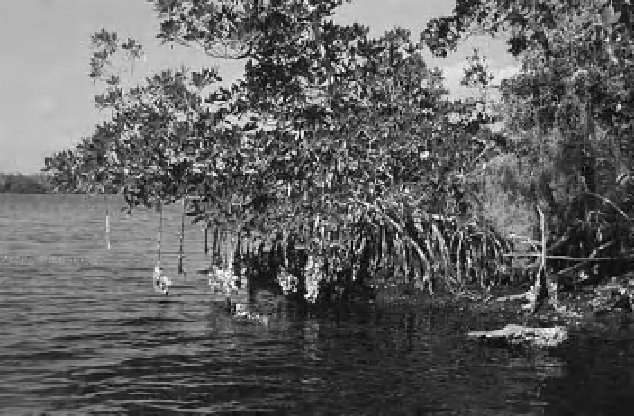Geoscience Reference
In-Depth Information
fresh-water marsh, deep-water swamp, tidal salt
marsh, and coastal mangrove. The fresh-water
marsh is dominated by Jamaica swamp sawgrass
(
Cladium jamaicense
, also known as Everglades
saw grass). Also common in this zone are aquatic
communities of lilies (
Nuphar
and
Nymphaes
sp.) and bladderworts (
Utricularia
sp.). On
limestone pinnacles, so-called hammocks
support various hardwood trees. Acidic leaf
litter has dissolved moats around the ham-
mocks, and many hammocks have a central
solution hole as well (Bryan, Scott and Means
2008). Among the more interesting inhabitants
are brightly colored tree snails (
Liguus fascia-
tus
), which are endemic to southern Florida,
Cuba, and Hispaniola (Dugan 2005). Snail popu-
lations in each hammock have unique color
patterns (Bryan, Scott and Means 2008).
Deep-water swamps of Big Cypress Swamp
contain bald cypress (
Taxodium distichum
) and
other woody vegetation growing in standing
water. Much of this swamp was subjected to
heavy logging, but some portions are still well
preserved. This region is home to most of the
remaining Florida panthers (see Fig. 7-48). Tidal
salt marsh and mangrove occupy the coastal
zones, in which water chemistry varies from
slightly brackish to fully marine (Fig. 15-14). The
Everglades contains the world's largest contigu-
ous tract of mangrove swamp in the subtropics
(Doyle, Krauss and Wells 2009).
Several major hurricanes have crossed the
Everglades in recent decades, including Wilma
and Katrina in 2005 and Andrew in 1992 (Fig.
15-15). Hurricane impacts on the mangrove
forest include the following (Doyle, Krauss and
Wells 2009; Krauss et al. 2009; Smith et al. 2009;
Whelan et al. 2009):
• Greatest damage is coni ned to a narrow
coastal zone, 50-500 m wide that may extend
for tens of kilometers in length.
• Some heavily damaged zones may recover,
but others are permanently converted into
intertidal mudl ats.
• Mangroves are felled above a critical wind
speed of 110 miles per hour (177 km/h),
the threshold between categories 2 and 3
hurricanes.
• Substantial sediment is deposited that may
raise soil surface elevations by
4 cm. Even
after a year of compaction and erosion, the
soil surface remains
>
>
3 cm above pre-storm
level.
Figure 15-14.
Red mangrove (
Rhizophora mangle
) exposed at low spring tide in brackish water of Whitewater Bay.
Oysters cling to prop roots that are normally submerged, and Spanish moss hangs from upper branches of the
mangrove. The mangrove is rooted in peat, which can be seen just above water level. Photo by J.S. Aber; Everglades
National Park, Florida.





